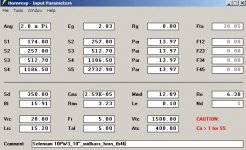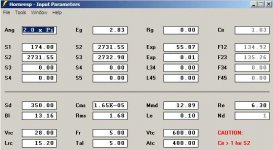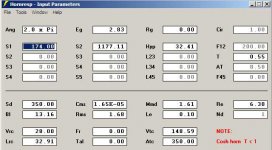Yes paper citations that are not truly accessible are just a little bit annoying.
I can discuss anecdotal evidence about what works but sometimes it is very enlightening to see what a more learned individual has studied and shared and put the math foundations into. I am a sad mathematician, I can do it but as I get older my abilities are getting rusty^3.
I can discuss anecdotal evidence about what works but sometimes it is very enlightening to see what a more learned individual has studied and shared and put the math foundations into. I am a sad mathematician, I can do it but as I get older my abilities are getting rusty^3.
Via eMail
Post your address as a private message to me.
Regards,
WHG
I can gain read access to only two of the papers.
Is there a way to read any of the others? Without paying the AES for papers contributed by their Members !Probably not.
Post your address as a private message to me.
Regards,
WHG
I grew up with pounds/square inch (lb/in²)
and half converted to Newtons/square mm (N/mm²) in my professional career.
But Pascals have never been "natural" for me.
Would I be admitting to being lazy by asking for an easy way to "understand" or get a feel for what Pascals means in everyday terms?
Yes, I am lazy, I am asking for an easy way into Pascals.
Online Conversion - Pressure Conversion
What?
That is an attribution that applies to almost all citations; and if the citation references a text book, what then?
Attached files of the papers, get redacted here for copyright reasons.
If the author is still living, you can ask him/her for a copy.
I have yet to have such a request turned down.
Sometimes the affiliation’s website has a facsimile of the paper's content.
Alternatively, become an AES member.
Regards,
WHG
Yes paper citations that are not truly accessible are just a little bit annoying.
I can discuss anecdotal evidence about what works but sometimes it is very enlightening to see what a more learned individual has studied and shared and put the math foundations into. I am a sad mathematician, I can do it but as I get older my abilities are getting rusty^3.
That is an attribution that applies to almost all citations; and if the citation references a text book, what then?
Attached files of the papers, get redacted here for copyright reasons.
If the author is still living, you can ask him/her for a copy.
I have yet to have such a request turned down.
Sometimes the affiliation’s website has a facsimile of the paper's content.
Alternatively, become an AES member.
Regards,
WHG
Hi Y'all,
Epa's question (Post #2712) goes back to this thread: http://www.diyaudio.com/forums/subwoofers/213685-bass-my-soldier-16.html There in Post #158 I'm also referencing: http://www.diyaudio.com/forums/subwoofers/170771-single-sheet-th-challenge-26.html Here jbell shows his version of using an Eminence Beta-12A-2. The first case "Nathenry soldier mid" needs a midrange covering about 150-200Hz to 2-3kHz, the second case "jbell's mid" was designed to reach down to 100Hz.
Besides the really important theoretical discussion to which whgeiger has provided a wealth of background references (to which I sadly do not have access) it would be great if you could as mwmkravchenko puts it in Post #2721:"... discuss anecdotal evidence about what works..." Maybe from there we can see how we can use the information from Hornresp to arrive at a working design. And, maybe someone can chime in with practical experience as to what might be the better solution for Nathenry's "soldier mid".
Regards,
Epa's question (Post #2712) goes back to this thread: http://www.diyaudio.com/forums/subwoofers/213685-bass-my-soldier-16.html There in Post #158 I'm also referencing: http://www.diyaudio.com/forums/subwoofers/170771-single-sheet-th-challenge-26.html Here jbell shows his version of using an Eminence Beta-12A-2. The first case "Nathenry soldier mid" needs a midrange covering about 150-200Hz to 2-3kHz, the second case "jbell's mid" was designed to reach down to 100Hz.
Besides the really important theoretical discussion to which whgeiger has provided a wealth of background references (to which I sadly do not have access) it would be great if you could as mwmkravchenko puts it in Post #2721:"... discuss anecdotal evidence about what works..." Maybe from there we can see how we can use the information from Hornresp to arrive at a working design. And, maybe someone can chime in with practical experience as to what might be the better solution for Nathenry's "soldier mid".
Regards,
Anecdotally (sp)
I find two things when pushing up compression ratio, you can get quite and increase in efficiency. That is if the cone can take it. Second you can get a fairly good conservation in terms of enclosure size. The trade offs being that if you do not balance horn pat areas you end up with quite a bit of ripple.
Addressing ripple I have found that in the bass range to lower midrange a ripple up to plus or minus 3 db is not that objectionable.
So there goes it. Simple to the point. To describe what to do in every situation would take a text book. But play with your designs and see what you can squeeze out of them. I know of very successful bass horn designs done with very modest drivers that are fine with 8:1 compression ratios, and I have a horn sub kicking around in quite a few gentlemen's homes that is running almost 5:1.
I find two things when pushing up compression ratio, you can get quite and increase in efficiency. That is if the cone can take it. Second you can get a fairly good conservation in terms of enclosure size. The trade offs being that if you do not balance horn pat areas you end up with quite a bit of ripple.
Addressing ripple I have found that in the bass range to lower midrange a ripple up to plus or minus 3 db is not that objectionable.
So there goes it. Simple to the point. To describe what to do in every situation would take a text book. But play with your designs and see what you can squeeze out of them. I know of very successful bass horn designs done with very modest drivers that are fine with 8:1 compression ratios, and I have a horn sub kicking around in quite a few gentlemen's homes that is running almost 5:1.
what i get out af al reply's ,high cr is certenly doable but you need a sort of phase plug/rings to compensate path differences.
No.
The phase plugs are there for the purposes of pushing up high frequency response. That was the purpose of the papers posted by Mr. |Geiger. The papers were written to describe means and methods used to push up high frequency response of drivers in high frequency horns. As stated before you can push up the efficiency of a bass horn by means of the compression ratio. But you have to choose your balancing. Many drivers will survive higher pressures than you might think in the home setting. Truth to be told is that we don't push them all that hard for long periods of time. So bottom line is experiment, simulate, and carefully layout your horns. If you build them as per your simulation hornresp is very accurate at predicting what they will perform like.
1 pascal = 0.000 145 037 738 01 pound/square inch.
So roughly ten thousand pascals to one PSI.
Choosing the right cone makeup will let you work with higher pressures. So pick a cone that you can't deform to easily with your hands.
Hi mwmkravchenko,
"...pushing up high frequency response..."
I just posted a mid-range horn with the Selenium 10PW3 in Post #188 here: http://www.diyaudio.com/forums/subwoofers/213685-bass-my-soldier-19.html Do you think it will make 2kHz?
Regards,
"...pushing up high frequency response..."
I just posted a mid-range horn with the Selenium 10PW3 in Post #188 here: http://www.diyaudio.com/forums/subwoofers/213685-bass-my-soldier-19.html Do you think it will make 2kHz?
Regards,
Some basics.
Your throat must be smaller than the wavelength of sound you wish to create. If it is larger than the upper frequency you wish to reproduce it will not work so well.
Next.
You need a driver that will get you this high in frequency response anyway. This is directly related to the drivers voice coil inductance. Remember that to large an inductance cuts out high frequency. And there is pretty much nothing you can do about it.
Driver choice is very important. So as a quick way to figure out the high frequency response try the driver out in hornresp in a sealed or vented enclosure. The low end is unimportant take a look at the high frequency response.
Your throat must be smaller than the wavelength of sound you wish to create. If it is larger than the upper frequency you wish to reproduce it will not work so well.
Next.
You need a driver that will get you this high in frequency response anyway. This is directly related to the drivers voice coil inductance. Remember that to large an inductance cuts out high frequency. And there is pretty much nothing you can do about it.
Driver choice is very important. So as a quick way to figure out the high frequency response try the driver out in hornresp in a sealed or vented enclosure. The low end is unimportant take a look at the high frequency response.
So roughly ten thousand pascals to one PSI.
Less roughly, 6895 Pa = 1 psi
Kind regards,
David
Hi David,
I found something I don't understand (well, nothing new there). Going into an existing simulation, I went to Edit/Tools/System Design/From Specification/Yes/200/2000/OK, and the program calculated new horn values for S1/S2/Hyp. That was expected. But then I noticed that the program also changed the Mmd from 12.89 to 1.61. Bug, or feature? Version 29.10 Product Number 2910-120519.
Regards,
I found something I don't understand (well, nothing new there). Going into an existing simulation, I went to Edit/Tools/System Design/From Specification/Yes/200/2000/OK, and the program calculated new horn values for S1/S2/Hyp. That was expected. But then I noticed that the program also changed the Mmd from 12.89 to 1.61. Bug, or feature? Version 29.10 Product Number 2910-120519.
Regards,
Attachments
Hi David,
I found something I don't understand (well, nothing new there). Going into an existing simulation, I went to Edit/Tools/System Design/From Specification/Yes/200/2000/OK, and the program calculated new horn values for S1/S2/Hyp. That was expected. But then I noticed that the program also changed the Mmd from 12.89 to 1.61. Bug, or feature? Version 29.10 Product Number 2910-120519.
Regards,
If you want to keep the driver, you should use System Design/With Driver. System Design From Specification also calculates driver parameters, but I have never seen a case where only Mmd changes. Usually other driver parameters change as well.
Regards,
Bjørn
- Home
- Loudspeakers
- Subwoofers
- Hornresp


